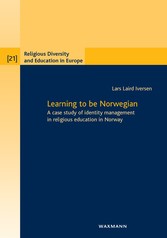Suchen und Finden
Service
Mehr zum Inhalt

Learning to be Norwegian. A case study of identity management in religious education in Norway
Buchtitel
1
Acknowledgements
5
Contents
7
List of Abbreviations
10
Part I: Introduction
11
1. Introduction
11
Part II: Literature
17
2. Multiculturalism
19
2.1 Overview of multiculturalism
19
2.2 Mainstream multiculturalism
21
2.3 Critiques of Multiculturalism
22
2.4 Contemporary debates
24
2.5 Concluding remarks
30
3. Norwegian sexualities
32
3.1 Introduction
32
3.2 The work of Åse Røthing, an example of the Norwegian Sexualities Approach
33
3.3 Discussion
35
4. The interpretive approach to religious education
38
4.1 The interpretive approach: A presentation
38
4.2 Relating the interpretive approach to other approaches toreligious education
40
4.3 The interpretive approach compared to the religious literacy approach
41
4.4 Discussion
44
4.5 Three academic debates: A summary
50
Part III: Conceptual approach
51
5. Analytical horizon
52
5.1 Introduction
52
5.2 Ontological and epistemological background
52
5.3 Complexity reduction
54
5.4 Materiality
56
5.5 Difference
58
6. Toolkit for analysis
59
6.1 Viscosity
59
6.2 Boundaries
61
6.3 Work
63
6.4 Conclusions
65
Part IV: Research Design
67
7. Methodology: Case study and generalisation
68
7.1 Introduction
68
7.2 The art of generalising to a population
69
7.3 The logic of generalising to theory:
71
7.4 Why choose Norway?
72
7.5 Why choose education?
73
7.6 Case study conclusions
74
8. Methods
75
8.1 Methods introduction
75
8.2 Multiple methods
75
8.3 Choice of texts
77
8.4 Document analysis: Analytical strategy
80
8.5 Selecting schools
81
8.6 Gaining access to schools
83
8.7 Research role: My presence in the field
85
8.8 Method conclusions
87
Part V: Background
89
9. Historical Background
90
9.1 Religious education and national identity in Norway: Introduction
90
9.2 Building the state, becoming Norwegianand developing modernity
91
9.3 The historical background: Some analytical points
93
9.4 Contexts for the contemporary subject
96
9.5 The contemporary subject: Implementing KRL
100
9.6 The contemporary subject: The legal history of KRL and RLE
104
9.7 The modern subject: The revisions
105
9.8 The modern subject: As it stands today
107
9.9 Conclusions
108
10. The schools. An ethnographic context
110
10.1 Introduction
110
10.2 Four vignettes from classrooms: Dealing with disagreement
111
10.3 Differences between the schools
114
10.4 Similarities between the schools
117
10.5 Conclusions
121
Part VI: Analysis
123
11. Document analysis: Values, religion and identity in the formal curriculum
124
11.1 Introduction
124
11.2 Outlining the meaning web
126
11.3 The metaphorical structure of the values-node
137
11.4 Conclusion
141
12. Classroom analysis
143
12.1 Introduction
143
12.2 The boundary work of a Norwegian Muslim identity
144
12.3 The boundary work of a Norwegian Muslim identity: Analysis
146
12.4 The boundary work of a Norwegian enlightenment identity
152
12.5 The boundary work of a Norwegian enlightenment identity:Analysis
154
12.6 Boundary work and identity: Discussion
157
12.7 Conclusions
159
13. Relating to academic debates
161
13.1 Introduction
161
13.2 Representing religion in classroom: Developing the interpretive approach
162
13.3 National identity and Norwegian Sexualities
167
13.4 Multiculturalism
175
13.6 Conclusions
179
Part VII: Conclusion
181
14. Conclusion
181
Table of figures and examples
187
References
189
Alle Preise verstehen sich inklusive der gesetzlichen MwSt.








